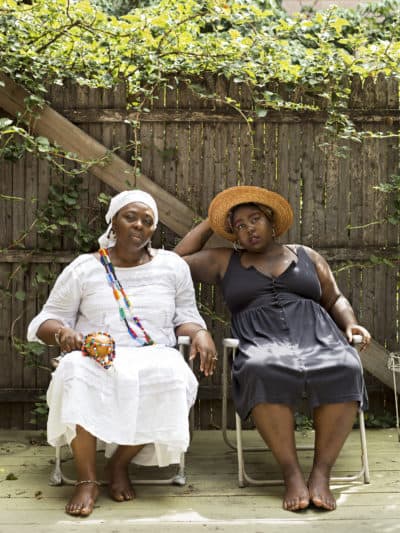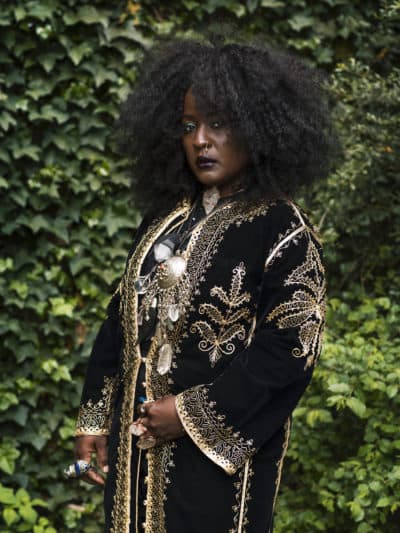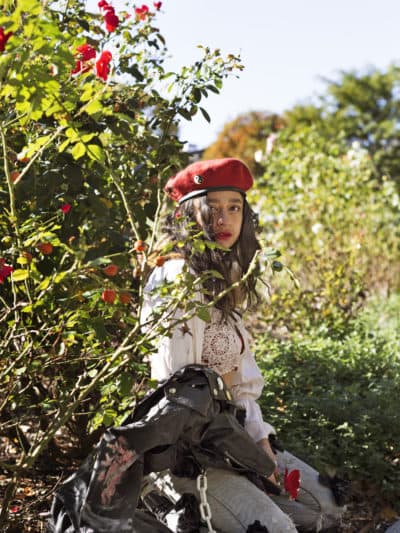Advertisement
At the Peabody Essex Museum, a new exhibit reclaims what it means to be a 'witch'

“Witch” is a term that is sometimes used as an insult. And in colonial Salem, the word was not just an invective, but a damning legal charge that could end in death. In 1692-93, more than 200 people, mostly women, were accused of “witchcraft” with 30 found guilty and 20 executed. Another five died in prison.
It was a term, says photographer Frances F. Denny, used to propagate fear and hate, often leveled for petty reasons against people outside the mainstream.
“It could have been your neighbor who had a better apple orchard than you,” she says. “There were lots of reasons why this word was thrown at people. But it was a very powerful one, one to be feared.”
And what of the witch in 2021?

In a series of portraits of modern-day witches, now on display as part of the exhibit “The Salem Witch Trials: Reckoning and Reclaiming” at the Peabody Essex Museum through March 20, Denny peers into a fascinating subculture that thrives today, but still often in the shadows and along the margins of acceptability. The portraits in the show are a small sampling of those appearing in Denny’s book “Major Arcana: Portraits of Witches in America,” published last year, featuring carefully composed photographs of a diverse group of women who are of varying ages, races and backgrounds.
They call themselves neo-pagans, occultists, herbalists, healers and Wiccan high priestesses. Accompanying each of the 13 portraits is a short text explaining how each woman defines what it means to be a witch.
“A ‘witch’ is any woman who is grounded in her power, able to manipulate/shift energy for her highest good whether in the boardroom, the bedroom, or the kitchen,” reads text from Marie C. Nazon, a New York witch also known as Mambo Yasezi. “Any woman who uses the knowledge of the forces of nature to heal or consciously manifest, is a witch.”
In addition to being a witch, Nazon is also a licensed clinical social worker and a faculty counselor at The City College of New York.
“‘Witch’ is totally political for me,” reads text written by Nazon’s daughter, Ébun Zoule, a drummer with the band T-Rextasy. “It is a political practice in that it allows folks to manifest things for themselves and their communities rather than relying on a capitalist system.”
Denny grew up in Brookline but now lives in New York. She spent three years traveling the country to snap these photos. Her travels — to California, Louisiana, Indiana and up and down the East Coast — were motivated by her own curious connection to the Salem witch trials. A few years before embarking on the project, Denny discovered that her 10th great-grandfather was one of the central judges in the trials. It also turned out that her 8th great-grandmother had been one of the accused.
Advertisement
“It felt meaningful and irreconcilable to be descended from both a sort of oppressor figure and the oppressed figure,” says Denny. “I started thinking about what I wanted to do with this natural coincidence and how I wanted to address that and have it not really actually be about me, but to make it about the people who have reclaimed this word. I am trying to represent these individuals with respect and dignity and also not trying to explain away all the mystery with the pictures.”

And so, one of the portraits in the show is of Shine Blackhawk, a New York witch who stands regally in a velvety tunic embossed with gold embroidery. She is surrounded by trees. Her mane of curls and nose ring suggest a freedom echoed in her explanation of her brand of witchcraft. She describes it as “wild” and “eclectic” informed by Black Native American folk spirituality. Another portrait is of Alex Patrick Dyck, a Brooklyn witch who in her photo is outfitted in jeans and a red beret adorned with the yin yang symbol. A witch, she says, is a person unafraid to tap into the unknown to heal.
“I think that as a portraitist, I'm always thinking about the ways in which a photograph is a reduction in some way,” says Denny. “You're taking a living, breathing, three-dimensional human being and translating them into a single static frame. I think my job as a photographer is to complicate that translation so that the result is not two-dimensional but as complex as possible.”
To capture a photo that would accurately represent each witch, Denny allowed her subjects to choose the location of the shoot as well as what they would wear. She found her subjects initially, she says, through “intuition,” and those first subjects spread the word to their friends. She also scouted for subjects at witchcraft festivals, shops, bookstores and even on social media.
“It was really important to me, though, that this was not just an Instagram photo project,” says Denny. “It had to reflect diversity.”
Denny’s photographs are just one section of a larger exhibit divided into three sections. The first part of the show features historic artifacts owned by both the accused and accusers in the witch trials. One object on view is a trunk belonging to Jonathan Corwin, an infamous witch trial judge. Another section of the exhibit is dedicated to English fashion designer Alexander McQueen, who it turns out, is a descendent of someone who was caught up in the Salem hysteria. His ancestor, Elizabeth How, was one of the first women to be condemned and hung as a witch in Salem in 1692. In honor of his unjustly accused forebear, McQueen designed his fall/winter 2007 collection “In Memory of Elizabeth How, 1692” featuring seductive Goth-edged fashions incorporating symbols of pagan worship.

“Being in Salem, there is a vibrant witch community, but what does that mean?” asks Lydia Gordon at a press preview. Gordon is co-curator of the exhibit with Dan Lipcan and Paula Richter. “We understand how the term ‘witch’ was understood in the 17th century… No one was celebrating that identity. And so, how is the witch community today reclaiming that word? Who are witches and what does witchcraft look like and what does that practice look like?”
Denny says she can’t quite pin down when witchcraft evolved into something of which to be proud. Although women in medieval and colonial times were condemned as witches whenever they threatened patriarchal norms, by the end of the 19th century, both female and male occultists enjoyed a measure of acceptance in avant garde circles. Today, the taboo against witches seems nearly over, as astrology, tarot, crystals and magic move into the mainstream.
The acceptance may be a logical consequence of the rise of feminism and the decline in trust in establishment ideals. It may also appeal to those of looking for alternative ways to change a system that won’t budge.
“It's murky and hard to pin down,” says Denny of the transformation. “‘Witch’ is a word that has a lot of baggage. It's heavy. So, there's something really poignant about the fact that these individuals have reclaimed it from these shadowy origins and turned it into something powerful.”
“Salem Witch Trials: Reckoning and Reclaiming” is on view through March 20.
